Supporting materials
Download
Download this article as a PDF

Graham Gardner from the Inter-Community School in Zürich, Switzerland, describes how an attempt to interest his students in chemical separation techniques developed into a full-scale interdisciplinary detective mystery.

I had been teaching a unit on chemical separation techniques to my 8th grade class (14-year-olds) for several years and noticed that it was one of the most tedious parts of the science course for these students. The unit introduced them to a range of techniques from the obvious and simple method of filtration to the more abstract and complicated technique of chromatography. The most common question the unit raised from students was “what’s the point?”
So with one particularly difficult group of students, I introduced a practical test situation where four suspects of a crime had various samples taken from them. The students were given pre-analysed samples from the crime scene that they then had to match to their own analysis from each suspect. The two lessons I set aside for this activity quickly became four. The students all arrived at class well before each lesson started with lab coats and safety glasses on (normally I have to repeat this instruction several times). At the end of each class I even had to throw them out to let my next class in. They wanted more time – even asking to work during breaks and lunchtimes! They had been one of my least motivated classes and now my colleagues were asking what I had done to make them work so diligently – had I punished them or threatened them? One of the most motivating aspects for the students was the final explanation of their analysis, normally a boring written activity. It became a courtroom drama, and the students became expert witnesses and lawyers who had to cross-examine (exploiting their natural tendency to be argumentative).
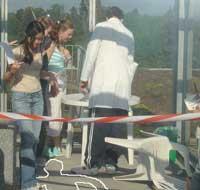
The following year, the activity was expanded to a full-day activity. It was still a science activity at this point, but as the timetable had been abandoned for the day, non-science teachers were also involved. They quickly picked up on the potential for the activity to involve many other subjects. From this point on, it became an established interdisciplinary activity in the school year.
The students do not know in advance when the mystery will take place but they all anticipate it as they have heard about it from previous years’ groups.
Over the eight years that the detective mystery has been running, we have had input from the English department through the study of the detective novel as a genre of literature; one year, the students went to the Giessbach Falls to see where Sherlock Holmes met his end. I’ve even managed to get Shakespeare’s Macbeth in somehow.
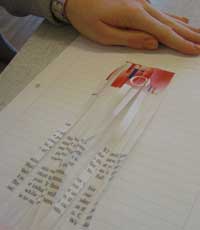
Usually four teachers play the role of the suspects (with suspect photographs) whom the students have to interview. All the students study German as we are located in Zürich, so we have one suspect who will only answer questions posed in German. Sometimes we include a suspect who only speaks French, as that is also a language offered in our curriculum.
One year, we had a crime that revolved around the theft of a $2 million crystal that was on display in the school library. The technology teacher made a glass display case full of anti-theft devices. The school’s website advertised the crystal as being an archaeological find on the site of the school when its foundations were being built. It claimed that the local museum had loaned it to us for an exhibition. Most people fell for it and the library was constantly visited by students and teachers amazed by the crystal. Comments overheard by the librarian included “huh, I don’t think much of their security system, we could easily steal this” and from a teacher “I can’t believe the headmaster didn’t tell us about this before.” I’d made a fake picture of the headmaster digging the crystal out of the ground.
On the day of the activity, in a very hushed assembly, the students were told that the stone had been stolen. As we then explained that they would have to solve the crime, it started to dawn on them that it was part of the mystery. As well as the usual analysis, the students had to work out how the thief had bypassed the security system – by trying to break the system themselves.
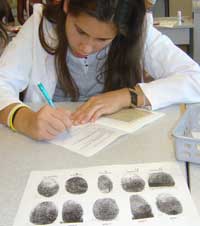
For the last two years, we have had a humanities/science energy conference at the school. Each group of students represents an energy source and they make a presentation stand on the exhibition floor. Teachers in character attend, along with students from other grades and parents. The crime from the mystery is connected to some of the characters that the teacher delegates play, as well as being related to an energy issue.
This year, for example, the mystery revolved around a new species of oil seed that would revolutionise the energy industry. A delegate at the conference had recently discovered the seed in the Amazon rainforest but had not made the seed available or his findings public. Rumours about oil companies and governments trying to get hold of the seed set the scenario for the delegate’s mysterious death. We then introduce energy from a science perspective, and the humanities teachers investigate the social issues.
The basic elements of the detective day are:
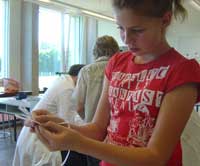
Such an activity requires a lot of preparation so it is important that the school administration fully supports the activity by allowing planning time, especially if it involves teachers from different disciplines. Originally, when I just had the activity in the science class, it only took a few hours to prepare. Involving the suspects, interviews, surveillance, setting up lots of clues such as a database of records, as well as the little movie I always make to introduce it, takes many, many hours. The more complex the mystery, the more time it takes to prepare. This year’s activity probably took 15-20 hours.
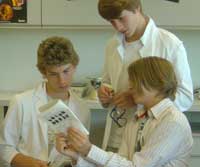
The main issue that I’ve had with the mystery has been the insensitive nature of dealing with death as a fun activity. The crystal theft successfully got around this but in trying to have a different scenario each year, I have gone back to a murder investigation.
A former colleague once pointed out that detective novels and TV programmes such as CSI treat death as entertainment and children are not only exposed to this but thrive on it. Macbeth, which the 8th grade is also studying, is not short on bloody murders and it is not likely to be removed from the curriculum.
It may be an interesting aspect for the school counsellor to explore, and certainly in terms of the students’ imagination, the more gory aspects come out in full when we get them to dramatise how they thought the crime had been committed.
This article represents a great idea, which needs much time for planning and co-ordination. I am fully convinced that the students will find these activities more exciting than traditional educational methods. I think guiding the students through detective mysteries like those mentioned in the article is very motivating, and another valuable source for teachers searching for different educational methods.
Sølve Tegner Stenmark, Norway
Download this article as a PDF